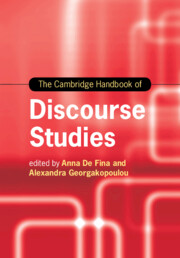Book contents
- The Cambridge Handbook of Discourse Studies
- Cambridge Handbooks in Language and Linguistics
- The Cambridge Handbook of Discourse Studies
- Copyright page
- Contents
- Figures
- Tables
- Contributors
- Preface
- Part I (Con)Textualizing Discourses
- Part II Perspectives and Modes of Analysis
- Part III Discourse Materialities and Embodiment
- 12 Multimodality
- 13 Sign Theory and the Materiality of Discourse
- 14 Discourse and the Linguistic Landscape
- 15 Discourse, Emotions and Embodiment
- 16 Posthumanism and Its Implications for Discourse Studies
- Part IV (Trans)Locations and Intersections
- Part V Ethics, Inequality and Inclusion
- Part VI Discourses, Publics and Mediatization
- Index
- References
16 - Posthumanism and Its Implications for Discourse Studies
from Part III - Discourse Materialities and Embodiment
Published online by Cambridge University Press: 28 September 2020
- The Cambridge Handbook of Discourse Studies
- Cambridge Handbooks in Language and Linguistics
- The Cambridge Handbook of Discourse Studies
- Copyright page
- Contents
- Figures
- Tables
- Contributors
- Preface
- Part I (Con)Textualizing Discourses
- Part II Perspectives and Modes of Analysis
- Part III Discourse Materialities and Embodiment
- 12 Multimodality
- 13 Sign Theory and the Materiality of Discourse
- 14 Discourse and the Linguistic Landscape
- 15 Discourse, Emotions and Embodiment
- 16 Posthumanism and Its Implications for Discourse Studies
- Part IV (Trans)Locations and Intersections
- Part V Ethics, Inequality and Inclusion
- Part VI Discourses, Publics and Mediatization
- Index
- References
Summary
This chapter maps the emerging conceptual terrain of posthumanism and its relevance for discourse studies, with a particular focus on sociolinguistics and applied linguistics work. Posthumanism is a label applied to a range of theoretical and methodological approaches across the humanities and social sciences that are calling into question dominant assumptions generated by Western Enlightenment thinking about the human by giving greater consideration to the role of material objects, animals and the environment in understanding the social world. Posthumanism thus considers the implications of the central role of materialism in our understandings of human agency, language, cognition and society. For discourse studies, a turn to posthumanism requires us to examine the role of discourse in how humans become entangled with the material world through their everyday embodied interactions with objects, artifacts, technologies, plants, animals, and the built and natural environment. Through embracing an activity-oriented perspective toward these human–nonhuman entanglements, the implications are that we must rethink modernist categorical boundaries between subject/object, human/nonhuman and society/nature, both within metadiscourses about these dichotomies and through a more microanalytic lens in the analysis of text and talk.
Keywords
- Type
- Chapter
- Information
- The Cambridge Handbook of Discourse Studies , pp. 350 - 370Publisher: Cambridge University PressPrint publication year: 2020
References
Further Reading
This article offers a reframing of “competence” by examining how multilingual STEM scholars engage in their work through linguistic, embodied and material resources. Building on conceptual insights from new materialism and Actor-Network theory, it explores some of the methodological implications of posthumanist thinking for discourse analysts.
In dialogue with emerging posthumanist multispecies studies, this ethnography investigates the semiotic entanglements of Ecuadorian Quichua-speaking Runa with the plants, animals and ecosystems they interact with in the Amazon. In challenging anthropocentric thinking about language, discourse and representation, the book offers an innovative understanding of semiosis as not only human but an emergent property of all living beings or “selves.”
This book offers an in-depth introduction to Actor-Network theory from one of the key figures in its development. Divided into two parts, it first provides an overview of the theoretical influences motivating ANT’s call for a shift from a “sociology of the social” to a “sociology of associations.” The second part guides readers through the methodological principles underpinning ANT.
This book introduces posthumanism to the field of applied linguistics by arguing against the popular conception that language is the key to human exceptionalism. Pennycook dismantles this logic by drawing attention to the embodied, material and distributed nature of language.
This book offers an introduction to nexus analysis and remains a cutting-edge example of a posthumanist orientation to ethnographic discourse analysis. The method is illustrated through an investigation of how early internet communication mediated Alaska Natives’ access to various institutional assemblages in the 1980s. The appendix of the book further summarizes the key principles of nexus analysis in a highly useful “field guide” for examining posthumanist actor-networks and assemblages.
References
- 4
- Cited by

